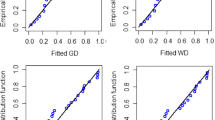Overview
- Authors:
-
-
N. Balakrishnan
-
Department of Mathematics and Statistics, McMaster University, Hamilton, Canada
-
Rita Aggarwala
-
Department of Mathematics and Statistics, University of Calgary, Calgary, Canada
Access this book
Other ways to access
About this book
Censored sampling arises in a life-testing experiment whenever the experimenter does not observe (either intentionally or unintentionally) the failure times of all units placed on a life-test. Inference based on censored sampling has been studied during the past 50 years by numerous authors for a wide range of lifetime distributions such as normal, exponential, gamma, Rayleigh, Weibull, extreme value, log-normal, inverse Gaussian, logistic, Laplace, and Pareto. Naturally, there are many different forms of censoring that have been discussed in the literature. In this book, we consider a versatile scheme of censoring called progressive Type-II censoring. Under this scheme of censoring, from a total of n units placed on a life-test, only m are completely observed until failure. At the time of the first failure, Rl of the n - 1 surviving units are randomly withdrawn (or censored) from the life-testing experiment. At the time of the next failure, R2 of the n - 2 -Rl surviving units are censored, and so on. Finally, at the time of the m-th failure, all the remaining Rm = n - m -Rl - . . . - Rm-l surviving units are censored. Note that censoring takes place here progressively in m stages. Clearly, this scheme includes as special cases the complete sample situation (when m = nand Rl = . . . = Rm = 0) and the conventional Type-II right censoring situation (when Rl = . . . = Rm-l = 0 and Rm = n - m).
Similar content being viewed by others
Article
Open access
16 November 2020
Table of contents (11 chapters)
-
-
- N. Balakrishnan, Rita Aggarwala
Pages 1-10
-
- N. Balakrishnan, Rita Aggarwala
Pages 11-29
-
- N. Balakrishnan, Rita Aggarwala
Pages 31-40
-
- N. Balakrishnan, Rita Aggarwala
Pages 41-65
-
- N. Balakrishnan, Rita Aggarwala
Pages 67-83
-
- N. Balakrishnan, Rita Aggarwala
Pages 85-115
-
- N. Balakrishnan, Rita Aggarwala
Pages 117-138
-
- N. Balakrishnan, Rita Aggarwala
Pages 139-165
-
- N. Balakrishnan, Rita Aggarwala
Pages 167-181
-
- N. Balakrishnan, Rita Aggarwala
Pages 183-214
-
- N. Balakrishnan, Rita Aggarwala
Pages 215-222
-
Back Matter
Pages 223-248
Authors and Affiliations
-
Department of Mathematics and Statistics, McMaster University, Hamilton, Canada
N. Balakrishnan
-
Department of Mathematics and Statistics, University of Calgary, Calgary, Canada
Rita Aggarwala




